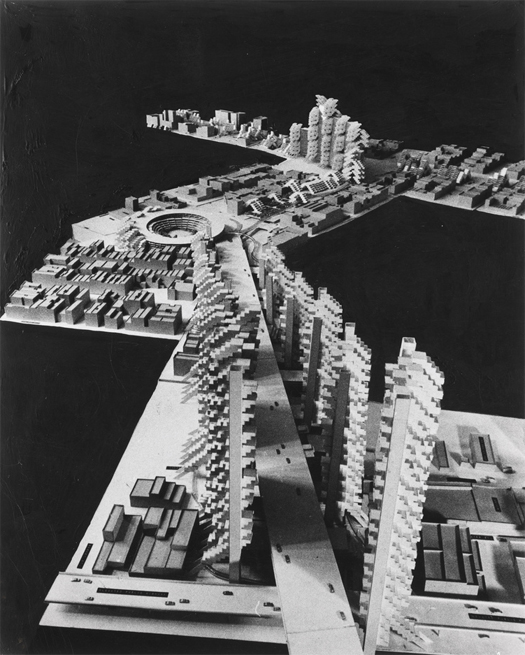
[Library of Congress images of Robert Moses and Paul Rudolph’s Lower Manhattan Expressway, via Pruitt-Igoe‘s flickr set]
1. A couple months ago, Slate published a series of articles by Tom Vanderbilt (author of Traffic, which I hear is excellent) on “Unbuilt Highways”, which began with the installment “How a Road Can Change a City, Even if It Never Gets Built”. I think the apparent appeal is obvious.
Unfortunately, the series is not quite what it seems. Essentially, it builds towards a re-iteration of conventional appreciation for cities that didn’t building highways through their inner neighborhoods, captured by Vanderbilt’s quote of Sara Mirk’s nicely inverted formulation: “when current transit planners visit from exotic Houston and D.C. to admire Portland’s progress, what they are really admiring are the roads not built—freeways erased from the maps decades ago.” This is definitely not wrong, but rather than the consideration of the changes wrought by unbuilt infrastructures which the article’s title promises, it’s only a nice twist on the relatively obvious notion that an unbuilt infrastructure won’t have the same effect on the city it would have had if it were built. (Of course, the title was probably not written by the author, so it’s hard to blame Vanderbilt for that disappointment.)
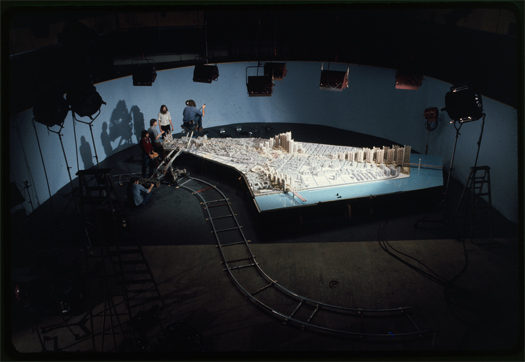
2. But we can talk about this idea anyways: that even when they aren’t built, the infrastructures that we propose still affect our cities.
This happens on two levels.
Once the Director of Planning has unveiled plans for an elevated expressway which will run right over your house, you can never look at those bricks and mortar the same way. They’ve become fragile, almost ephemeral, subject to the whims of the planners and their bulldozers. You and your neighbors can band together and put a halt to the project, but you can no longer pretend that your house is permanent, as the veil that hid its contingent nature has been ripped away, by something as thin and flimsy as a drawing, made by the right hands and invested with the right authority.
At the same time, the even more direct effect is that the city is physically marked by these plans. One of the few moments in that Slate article which comes close to being what the title promised is a sentence about Toronto’s canceled Spadina Expressway: “Ghosts of the Spadina still haunt the city today—for example… the windowless Spadina facade of the New College of the University of Toronto, [whose architects reasoned] “Why look out onto an expressway”?”. You don’t have to build it; you just have to make other architects and planners think you might build it, and they’ll design as if that empty space were filled by the concrete and steel you’ve proposed. Buildings and landscapes, permanently marked by the absence of a thing that never happened.
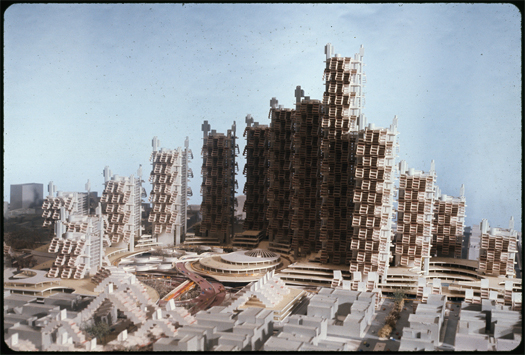
3. Vanderbilt’s choice of the word “haunt” seems particularly appropriate, and suggests a question: what other unbuilt infrastructures haunt our cities?
What longings in the psyches of unheralded civil engineers and forgotten mid-century planners do the absurdly tall and over-engineered spans of an interchange like the intersection of Chippenham Parkway and I-95 signal? How do their unbuilt counterparts relate? Will we see in the coming decades histories of the Crosstown Expressway and Beverly Hills Freeway which (perhaps a bit like Pruitt-Igoe‘s defense of that much-maligned housing project) invert their contemporary place in history — reading them not as potential tragedies averted by noble citizen resistors, but as possible monuments or vital linkages lost to the first glimmerings of a disastorous NIMBYism? (This is hard to imagine, given how much truth there is in both the initial resistance to ill-advised mega-projects and the contemporary valorization of that resistance, but still one wonders.)
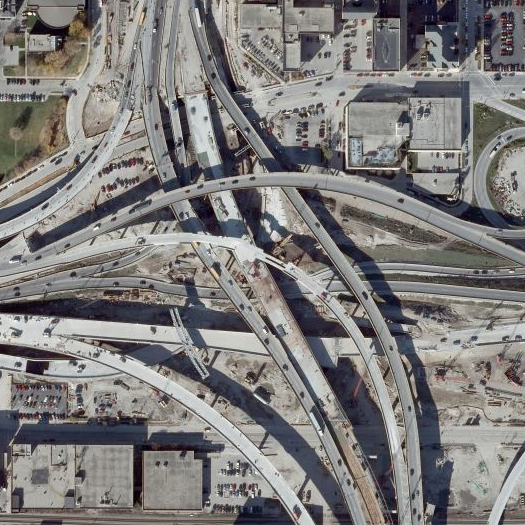
[The Marquette Interchange in Milwaukee, under construction; image via Bing Maps.]
It’s relatively easy to see how a highway does this, given the kind of cutting impact it has on a city’s physical fabric; but what of an unbuilt subway? Do politically-connected developers buy up land around phantom subway stops, only to watch their real estate empires crumble when the will to fund the new lines evaporates? What happens to the leftover land? Or harder to see: unbuilt transmission lines, unfunded sewer tunnels, power plants that no one wanted to live near, public wi-fi networks never realized by contracted private service providers. And not every unbuilt infrastructure is produced in a city planning office: the internet is nothing if not an archive that permits us to browse and share one another’s unrealized fantasies, and so it is awash in pet projects which explain how infrastructures should be expanded and contracted.

4. Someone please hire me to teach a seminar on unbuilt mega-infrastructures.
We’d study opening and re-appropriating the abandoned metro lines of Antwerp as everything from linear apartment complexes to subterranean public spaces.
We’d pour over archival plans for the full build-out of the interstate highway system, juxtaposing the plans with contemporary aerials, looking (like urban geologists tracing the forms of ancient oxbows) for the signatures of unbuilt infrastructures in sprawled land-use patterns.
We’d examine the the Great Recycling and Northern Development Canal, debating whether capturing the outflow of numerous Canadian rivers at their intersection with James Bay and diverting it south and west would be the economic and environmental boon proposal engineer Thomas Kierans claims it would be. We’d design that Canal’s vast system of “outflow-only, sea-level dikes”, carefully studying dike and sluice typologies, and staring at our proposals traced like “archaic glyphs” onto satellite photography of that bay in both verdant summer and ice-locked winter.
We’d compare and contrast the Canal with it’s slightly-better-known-yet-still-quite-obscure-and-entirely-unbuilt cousin, the North American Water and Power Authority, dividing ourselves into two factions, each equally determined to prove the superiority of our continent-wide river diversion scheme.
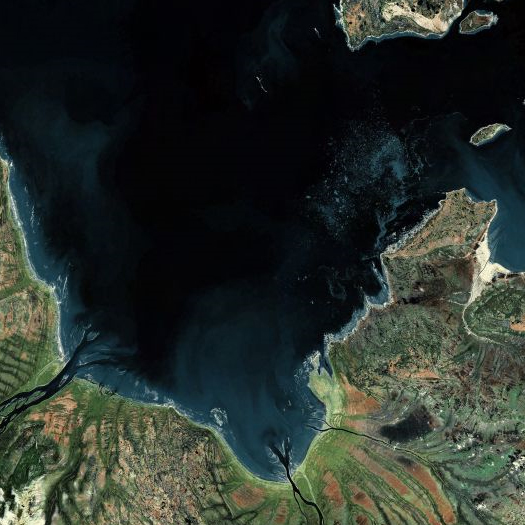

[Top: a portion of the south end of James Bay; bottom: the Ob River.]
And, of course, we’d have to devote a significant portion of our study to the equally outrageous unbuilt mega-infrastructures of Soviet Russia — like the Siberian River Reversal, a plan which dated back to the dreams of a 19th century surveyor in the employ of the tsar, Alexander Shrenk, and was seriously considered by Soviet leadership throughout the 20th century. By the mid-sixties, the plan called for reversing the flow of the Pechora, Kama, Tobol, Ishim, Irtysh, and Ob rivers. By the seventies, the Soviets had begun excavation around the Pechora and Kama — using, of course, 15-kiloton nuclear charges. (Opinions on whether the use of nuclear charges was environmentally sound were “divided”.) Progress was slow, though, and in the eighties, as the plan grew in scope and the Soviet government appeared increasingly serious about implementing it (Brezhnev officially sanctioned the scheme in a speech on agricultural policy), both internal and international opposition mounted, as this fascinating Time article from 1982 explains:
Now the old fantasy has taken on a staggering new reality. Under pressure from its water-needy Central Asian republics, and shaken by repeated agricultural failures, the Soviet leadership seems on the verge of sanctioning a water-diversion scheme that would be the grandest engineering project of all time. At least a dozen northerly-bound rivers would be reversed. By channeling 37.8 billion extra cubic kilometers of water a year to the south in European Russia and 60 billion cubic kilometers in Siberia, the project would greatly increase farm output in such arid regions as Uzbekistan and Kazakhstan, where the high birth rate of the largely Muslim population could overtake food production…
On the European side of the Urals, the volume of the Volga would be increased by funneling into it the flow of three major northern rivers, the Onega, the Northern Dvina and the Pechora. Officially sanctioned by President Leonid Brezhnev in his speech on agricultural goals two weeks ago, the European grand scheme is scheduled to be launched next year. The rerouting would require the building of 25 dams and numerous pumping stations. As the barriers go up, they would raise river levels a section at a time, until the water no longer reached the Barents Sea and the Arctic Ocean. The builders would also erect colossal dikes across the mouths of the rivers, creating great fresh-water bays. The first northern water should begin flowing southward into the Volga through a network of canals and reservoirs by the late 1980s.The Asian portion is no less ambitious, involving the rechanneling of Siberia’s mighty Ob River and its major tributary, the Irtysh. The original idea was to carry the water south by building a canal some 1,500 miles long, perhaps by nuclear blasting. But that proposal drew so many objections in the West that Soviet planners are now talking of rerouting the water along old riverbeds revealed by satellite photographs…
[But] the diversion, which would take 50 years to complete, would exact an enormous toll. In an area larger than Western Europe, tens of thousands of people would be displaced from their homes. Millions of acres of northern land would be flooded, including great tracts of game forest. Towns and villages would disappear, some of them with onion-domed churches dating back to the Middle Ages. No less disturbing, the diversion could drastically alter climate not only in the Soviet Union but throughout the Northern Hemisphere, even as far off as the U.S. and Canada.
So high and unpredictable are the social and ecological costs that an environmental debate has broken out in the Soviet Union. Ignoring the strictures against public dissent, an increasingly vocal group of Soviet climatologists, historians and distinguished citizens have joined local protesters—to say nothing of worried scientists abroad—in strong criticism of the scheme.
And so, having had our fill of grand and unrealized schemes — and having satisfied ourselves that, in many cases, both we and our planet are better off for their absences — we’ll then talk about how the cities they were never built in and never connected to have been changed by their absence.
And, of course, we’ll draw up the new mega-infrastructures of the 21st century — user-owned fog-farming networks and hovering re-purposed military drones broadcasting pirate wi-fi over financial districts and miles of coastal climate defense systems — never having any intention of building them, but carefully planning the effects that their proposal will have on our cities.
We will have a whole lot of fun.


Fantastic post!
In my profile of the CLUI for the next issue of GOOD, I accompany Matt Coolidge & Co. on a reconnaissance expedition round Culver City to do the research for a new tour they are putting together. One of the things we find is the ghost remnant of one of LA’s unbuilt freeways — La Cienega as it goes the Baldwin Hills becomes a divided highway, which was done in anticipation of the never-built Laurel Canyon freeway (one of 10 or so that were foreseen in the 1946 masterplan: http://www.cahighways.org/maps-sc-fwy.html)
Very nice — looking forward to seeing that profile. I think we’ve made it clear how we feel about CLUI.
‘Resuscitating Phantoms of the Wonderfully Unrealized’, or ‘Infra-Forensics of Bypassed Intentions’ (provisional titles for the seminar).
One note on Portland – it also built highways right through its center like everyone else. Rather than just removing them from the map (which it did), it took them out of the center of the realized: http://vintageportland.wordpress.com/2010/05/10/harbor-drive-1954/
Great piece, especially emphasizing the essentially political nature of any proposal, as opposed to project. How do you think digital information and access influences this aspect. I would imagine before, plans were unveiled and then word of mouth and editorials largely took over the narrative (I’m sure each case was different, and it was more complicated than that). But what now? How does the political nature of the internet affect the politics of mega-infrastructural proposals? I know that in New York City, every public DOT capital project must be published on the internet, in addition to being presented publicly, and there are all manner of maneuvers to make sure not too much gets out, or that certain aspects are or aren’t clear at 72 dpi…
That’s well-put — “the essentially political nature of any proposal”.
I’m not entirely sure what the ramifications of the digital distribution and discussion of proposals are, but along those lines, it’s pretty fascinating to note the delirious interest of the LaRouchies in implementing an updated NAWAPA plan — twenty-minute-long web presentations, an interactive Google Earth tour of NAWAPA, popping up in the comments on archived BLDGBLOG posts to argue for that implementation, etc.